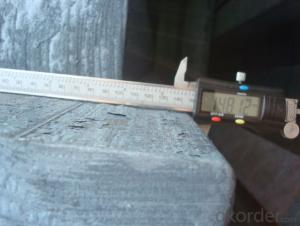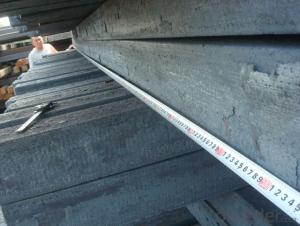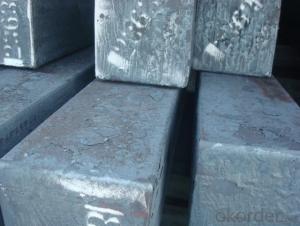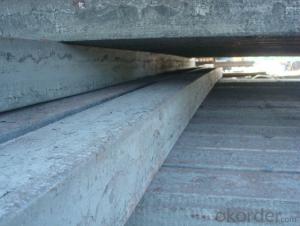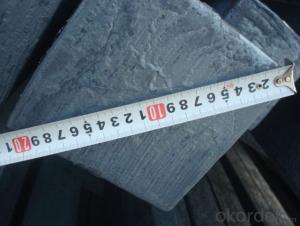Steel Billet Hot Rolled Q275 in Amazing Good Price
- Loading Port:
- Tianjin
- Payment Terms:
- TT OR LC
- Min Order Qty:
- 1000 m.t.
- Supply Capability:
- 50000 m.t./month
OKorder Service Pledge
OKorder Financial Service
You Might Also Like
1.Structure of Steel Billet
Steel billet(ingot) by cogging or breakdown of semi-finished products, is the raw material of all kinds of steel mill. Billet section of square, round, flat, rectangular and abnormity of several kinds of, mainly related to the shape of rolled products.
2.Main Features of Steel Billet
Rectangular billet continuous casting billet and mainly general carbon steel, low carbon low silicon cold-rolled material, high quality carbon structural steel, high strength low alloy steel, special steel, etc.
The billet is mainly divided into two kinds from the shape:
Slab: cross section width and height of the ratio of the larger, mainly used for rolling plate.
Billet: equal cross section width and height, or a huge difference, mainly used for rolling steel, wire rod. ,
Steel billets have distinct characteristics as compared with already furnished steel bars and products. Billets have a specific grain structure, which enables the metal to be processed more intricately. Steel billets are also known for their malleability and ductility, especially when exposed to varying temperatures during shaping and molding.
3.Steel Billet Images
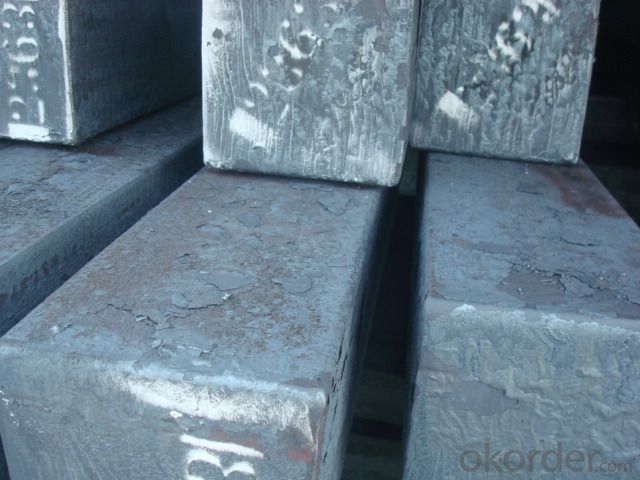
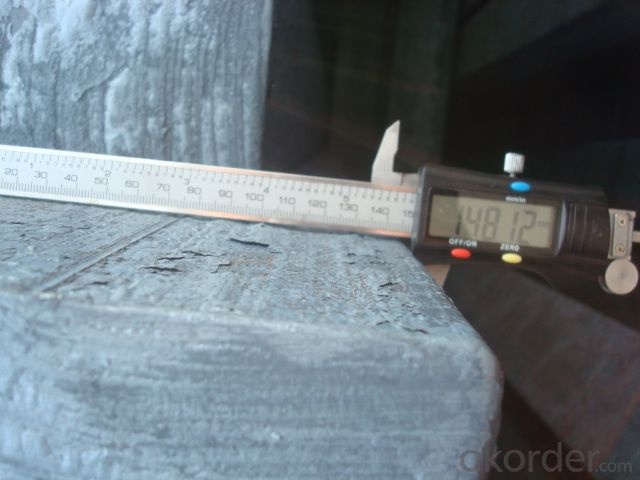
4. Steel Billet Specification
Hot rolled billet steel
Size: 50x50mm-180x180mm
Steel Grade: 3SP, 5SP,Q195,Q235,Q255,Q275 Length:3m-12m
MOQ: 1000MT/size
Payment term: TT or LC
Packing: in bulk , bundle
Shipment: by container , bulk vessel
Packaging Details: bundles with steel strips or as customers's requirements
Delivery time: 15-30 days after the deposit
Loading port:Tianjin, or other port China
Origin :China
Inspection:Third party inspection before loading.
5.FAQ
We have organized several common questions for our clients,may help you sincerely:
1) How about your company?
A world class manufacturer & supplier of castings forging in carbon steel and alloy steel,is one of the large-scale professional investment casting production bases in China,consisting of both casting foundry forging and machining factory. Annually more than 8000 tons Precision casting and forging parts are exported to markets in Europe,America and Japan. OEM casting and forging service available according to customer’s requirements.
2)If there’s something wrong with the quality of the products, how do we return the goods?
A: We promise you the quality will be the same as the samples you confirmed. If there’s something wrong with the quality of the products, please send back sample from the shipment goods to us and let us know the quantity, then we will investigate in our work shop. If it is our problem, we will offer you discount or replacements for free.
- Q: What are the main factors affecting the metallurgical properties of steel billets?
- There are several main factors that affect the metallurgical properties of steel billets. These factors include the composition of the steel, the heat treatment applied, the presence of impurities, and the cooling rate. The composition of the steel plays a crucial role in determining its metallurgical properties. The amount of carbon, as well as the presence of other alloying elements such as manganese, chromium, and nickel, can significantly impact the steel's strength, hardness, and ductility. Different compositions can also affect the steel's ability to resist corrosion or exhibit magnetic properties. Heat treatment is another important factor that affects the metallurgical properties of steel billets. This process involves heating the steel to a specific temperature and then cooling it at a controlled rate. Heat treatment can alter the microstructure of the steel, which in turn affects its hardness, toughness, and overall mechanical properties. Different heat treatment methods, such as annealing, quenching, and tempering, can be applied to achieve desired metallurgical properties. Impurities present in the steel can also influence its metallurgical properties. Common impurities include sulfur, phosphorus, and oxygen. These impurities can negatively impact the steel's mechanical properties, such as reducing its strength and ductility. Therefore, the level of impurities needs to be minimized to ensure the desired metallurgical properties. Lastly, the cooling rate during the solidification process plays a crucial role in determining the microstructure and properties of the steel billets. Rapid cooling, such as in the case of quenching, can result in a fine-grained microstructure, which enhances the steel's strength and hardness. On the other hand, slow cooling, such as during annealing, can lead to a coarse-grained microstructure, which improves the steel's ductility and toughness. In conclusion, the main factors affecting the metallurgical properties of steel billets include the composition of the steel, the heat treatment applied, the presence of impurities, and the cooling rate. These factors are interrelated and need to be carefully controlled to achieve the desired properties for different applications.
- Q: What are the main alloying elements used in steel billet production?
- The main alloying elements used in steel billet production are carbon, manganese, silicon, and chromium. Carbon is the most important alloying element, as it enhances the strength and hardness of the steel. Manganese is added to improve the toughness and hardenability of the steel. Silicon is added to enhance the steel's resistance to corrosion and oxidation. Chromium is used to increase the steel's hardness, corrosion resistance, and wear resistance. These alloying elements are carefully controlled and added to steel during the production process to achieve the desired properties and characteristics in the final steel billets.
- Q: What are the specifications for tool steel billets used in the tooling industry?
- Tool steel billets used in the tooling industry typically have specific specifications to ensure optimal performance and durability. These specifications include: 1. Composition: Tool steel billets are made from specific alloy compositions that provide high hardness, wear resistance, and toughness. Common elements found in tool steel include carbon, chromium, vanadium, molybdenum, and tungsten. 2. Hardness: Tool steel billets are heat-treated to achieve a desired hardness level, typically measured in Rockwell hardness (HRC). The hardness required depends on the specific application and the type of tool being produced. 3. Size and shape: Tool steel billets come in various sizes and shapes, such as rectangular or round bars, to cater to different tooling requirements. The dimensions of the billets are chosen based on the size and complexity of the tool being manufactured. 4. Surface finish: Tool steel billets should have a smooth and clean surface finish to ensure easy machining and minimize the risk of defects or imperfections in the final tooling product. 5. Tolerance: The billets should be manufactured with tight dimensional tolerances to ensure consistency during the machining and tooling processes. This helps in achieving precise tool dimensions and minimizing wastage. 6. Homogeneity: Tool steel billets should have uniform chemical composition and microstructure throughout to ensure consistent mechanical properties and performance of the final tooling products. 7. Heat treatment properties: The billets should have good heat treatment properties, including the ability to be hardened and tempered, to enhance their strength, toughness, and wear resistance. 8. Machinability: Tool steel billets should have good machinability to allow for efficient shaping and forming processes during tool manufacturing. This includes considerations for cutting forces, chip formation, and surface finish. It is important to note that the specific specifications for tool steel billets can vary depending on the application and the type of tool being produced. Manufacturers and tooling experts often work closely together to determine the most suitable tool steel specifications for each specific tooling requirement.
- Q: What are the challenges in welding steel billets?
- There are several challenges that can arise when welding steel billets. One of the main challenges is ensuring proper heat distribution during the welding process. Steel billets are often large and thick, which can make it difficult to evenly distribute heat throughout the material. This can result in inconsistencies in the weld, leading to weak spots or even failure of the joint. Another challenge is the potential for distortion and warping of the billet during the welding process. As heat is applied to the steel, it can cause the material to expand and contract, leading to unwanted changes in shape and dimensions. This can be particularly problematic when welding large or complex structures, as maintaining the desired shape and dimensions becomes critical. Additionally, steel billets can contain impurities and contaminants that can affect the quality of the weld. These impurities, such as sulfur, phosphorus, and other elements, can lead to the formation of brittle zones or other defects in the weld. Proper cleaning and preparation of the billet surface, as well as using appropriate welding techniques and filler materials, are necessary to mitigate these challenges. Furthermore, the high carbon content often found in steel billets can make them prone to cracking during the welding process. Carbon acts as a hardening agent in steel and can increase its susceptibility to cracking, especially if proper preheating and post-weld heat treatment procedures are not followed. Controlling the cooling rate and implementing stress-relieving techniques are essential in preventing cracking and ensuring the integrity of the weld. Lastly, the sheer size and weight of steel billets can present logistical challenges during the welding process. Handling and positioning these heavy objects require specialized equipment and skilled operators to ensure safety and accuracy. Additionally, the need for precise alignment and fit-up can be more challenging with large billets, requiring careful planning and execution. In conclusion, welding steel billets poses challenges such as heat distribution, distortion and warping, impurities and contaminants, carbon-induced cracking, and logistical issues. Overcoming these challenges requires expertise, proper equipment, and adherence to appropriate welding techniques and procedures.
- Q: How do steel billets contribute to the overall recyclability of a structure?
- Steel billets contribute to the overall recyclability of a structure because they can be easily melted down and reused in the production of new steel products. This reduces the need for raw materials and energy consumption, making the structure more environmentally sustainable. Additionally, the recycling process for steel billets is cost-effective, making it a viable option for manufacturers and builders.
- Q: Can steel billets be used for making architectural structures?
- Yes, steel billets can be used for making architectural structures. Steel billets are semi-finished products that are typically cast into specific shapes and sizes before being further processed into different steel products. These billets can be used as a raw material for fabricating various architectural structures such as beams, columns, frames, and trusses. Steel is a widely used material in the construction industry due to its high strength, durability, and versatility. It offers several advantages over other construction materials, including its ability to withstand heavy loads, resist corrosion, and provide excellent fire resistance. Steel billets can be processed and shaped into different forms, allowing architects and engineers to create innovative and complex architectural designs. Furthermore, steel structures offer several benefits in terms of cost-effectiveness, speed of construction, and sustainability. Steel is a highly recyclable material, making it an environmentally friendly choice. The use of steel billets in architectural structures enables the construction of large and complex structures with greater precision and efficiency. Overall, steel billets can be effectively used in the construction of architectural structures, offering numerous advantages in terms of strength, durability, design flexibility, and sustainability.
- Q: What are the different surface finishing techniques used for steel billets?
- There are several surface finishing techniques that are commonly used for steel billets. These techniques are employed to enhance the appearance, improve corrosion resistance, and provide a protective coating to the steel billets. Some of the different surface finishing techniques used for steel billets are: 1. Hot Rolling: This technique involves passing the steel billets through a series of hot rollers, which not only shapes the billets but also creates a smooth surface finish. Hot rolling is commonly used to produce steel plates, sheets, or structural shapes. 2. Cold Rolling: Cold rolling is similar to hot rolling, but it is performed at room temperature. This technique helps to achieve a smoother surface finish, increased dimensional accuracy, and improved mechanical properties of the steel billets. 3. Shot Blasting: Shot blasting is a process where steel billets are bombarded with small metallic or non-metallic particles at high velocity. This technique helps to remove scale, rust, and other contaminants from the billet's surface, resulting in a clean and uniform appearance. 4. Pickling: Pickling involves immersing the steel billets in an acid solution to remove oxides, scale, and rust from the surface. This technique helps to achieve a clean and smooth surface finish, ready for further processing or coating. 5. Galvanizing: Galvanizing is a popular surface finishing technique that involves coating the steel billets with a layer of zinc. This coating provides excellent corrosion resistance and protects the steel from environmental factors. Galvanizing can be done through hot-dip galvanizing, electro-galvanizing, or mechanical galvanizing methods. 6. Painting: Painting is often used as a surface finishing technique for steel billets. It involves applying a layer of paint or protective coating to the surface, which not only enhances the appearance but also provides protection against corrosion and weathering. 7. Passivation: Passivation is a chemical process used to remove free iron or iron oxides from the surface of steel billets. This process helps to improve the corrosion resistance of the steel and leaves a clean and passive surface. 8. Polishing: Polishing involves using abrasive materials or compounds to smoothen the surface of the steel billets. This technique is commonly used to achieve a high gloss or mirror-like finish, enhancing the aesthetic appeal of the steel. Each of these surface finishing techniques offers its own advantages and is chosen based on the specific requirements of the steel billets, such as appearance, corrosion resistance, and functionality.
- Q: How are steel billets used in the manufacturing of pressure vessel components?
- Steel billets are a crucial raw material in the manufacturing process of pressure vessel components. Pressure vessels are containers designed to hold gases or liquids at a significantly higher or lower pressure than the surrounding environment. These components are widely used in various industries such as oil and gas, chemical, and power generation. Steel billets, which are semi-finished products with a square or round cross-section, serve as the starting point for the production of pressure vessel components. They are typically made from carbon or alloy steel and undergo several manufacturing processes to transform them into the final product. The first step in the manufacturing process involves heating the steel billets to a specific temperature to make them more malleable. This process is known as hot working or forging. The heated billets are then subjected to pressure, either through hammering or rolling, to shape them into the desired form. This process helps to refine the structure of the steel and improve its mechanical properties. After the initial shaping process, the billets are further processed through a series of machining operations. This includes cutting, drilling, and milling to create the necessary features and dimensions required for pressure vessel components such as shells, heads, nozzles, and flanges. These machining operations ensure that the components meet the precise specifications and tolerances required for safe and efficient operation. Additionally, the steel billets may undergo heat treatment processes such as annealing, quenching, and tempering to further enhance their mechanical properties. Heat treatment helps to improve the strength, hardness, and durability of the steel, making it suitable for withstanding high pressures and corrosive environments. Once the pressure vessel components are machined and heat-treated, they undergo rigorous quality control inspections to ensure they meet the required standards and specifications. This includes non-destructive testing methods such as ultrasonic testing, radiographic testing, and liquid penetrant testing to detect any potential defects or flaws. In summary, steel billets play a crucial role in the manufacturing of pressure vessel components. They are transformed through hot working, machining, and heat treatment processes to create the final products. By using high-quality steel billets and employing stringent quality control measures, manufacturers can produce pressure vessel components that are safe, reliable, and capable of withstanding the demanding conditions they are designed for.
- Q: How do steel billets contribute to the mining industry?
- The mining industry relies heavily on steel billets, as they play a critical role in the manufacturing of various mining equipment and infrastructure. These semi-finished steel products are used to produce a wide range of tools and machinery necessary for mining activities. One of the primary uses of steel billets in the mining sector is in the creation of mining machinery and equipment. These billets are utilized to construct the structural components of heavy machinery like excavators, bulldozers, and drilling rigs. The strength and durability of steel make it an excellent material choice for these applications, as it can withstand the harsh conditions and heavy loads encountered in mining operations. Steel billets are also essential in the construction of mining infrastructure. The establishment of structures such as conveyor systems, processing plants, and storage facilities is a crucial aspect of mining operations. By using steel billets, the structural elements of these buildings can be fabricated to provide the necessary strength and stability needed to support mining activities. Additionally, steel billets are vital in the manufacturing of mining tools and equipment. Tools like drills, hammers, and picks are made from steel billets due to their strength and hardness. These tools are utilized throughout various mining processes, including exploration, extraction, and mineral processing. Moreover, steel billets contribute to the mining industry by facilitating the transportation of extracted minerals. The production of rail tracks and wagons, both of which are made from steel billets, is necessary for the efficient transportation of minerals from mining sites to processing facilities or ports for export. In conclusion, steel billets are an indispensable component of the mining industry. They support the production of machinery, infrastructure, tools, and transportation systems. With their strength, durability, and versatility, steel billets play a crucial role in driving the growth and efficiency of the mining sector.
- Q: What are the different types of surface treatment defects found in steel billets?
- Steel billets may have various types of surface treatment defects that can occur at different stages of the process. These defects can have an impact on the quality and performance of the billets. Below are some common types of surface treatment defects in steel billets: 1. Scale: This defect manifests as an oxide layer on the surface of the billet. It occurs when the steel is exposed to high temperatures during manufacturing, like hot rolling or heat treatment. Scale affects the appearance and surface quality of the billet and may need to be removed before further processing. 2. Pitting: Pitting is another defect characterized by small localized holes or depressions on the billet's surface. It can happen due to corrosion or chemical reactions during the surface treatment process. Pitting reduces the strength and durability of the billet, making it prone to further damage and failure. 3. Decarburization: This defect involves the loss of carbon from the surface layer of the billet. It can occur due to exposure to high temperatures or chemical reactions during manufacturing. Decarburization reduces the hardness and strength of the billet, affecting its overall performance and suitability for specific applications. 4. Staining: Staining refers to discoloration or blemishes on the billet's surface. It can happen due to the presence of foreign substances like rust or contaminants during the surface treatment process. Staining affects the appearance and aesthetics of the billet, but it may not necessarily impact its mechanical properties. 5. Scratches and Abrasions: These physical defects occur during handling, transportation, or processing of the billet. They appear as visible marks or grooves on the surface and can affect the overall quality and appearance of the billet. While scratches and abrasions may not significantly impact the billet's mechanical properties, they compromise its surface integrity and may require further treatment or repair. Identifying and addressing these surface treatment defects in steel billets is crucial to ensure the desired quality and performance of the final product. Implementing proper inspection, monitoring, and control measures during the surface treatment process can help minimize or eliminate these defects, resulting in superior steel billets.
Send your message to us
Steel Billet Hot Rolled Q275 in Amazing Good Price
- Loading Port:
- Tianjin
- Payment Terms:
- TT OR LC
- Min Order Qty:
- 1000 m.t.
- Supply Capability:
- 50000 m.t./month
OKorder Service Pledge
OKorder Financial Service
Similar products
Hot products
Hot Searches
Related keywords









